по Sofy Becerril 4 лет назад
501
Educación para un México Intercultural

по Sofy Becerril 4 лет назад
501

Больше похоже на это

To name your story, you have to think about the overall message and what you want your audience to understand from the story. Also, make it relevant and easy to remember.
The ending of a story is essential. We all know that if the ending is weak, what happened before loses its importance. So make it unpredictable, but fair. A resolved ending answers all the questions and ties up any loose threads from the plot.
This is the closure section of the story.
See examples of possible outcomes below:
This is the moment when the main character surpasses the last obstacle and finally faces their greatest challenge.
The climax usually follows one of these patterns:
Type in your answer.
The middle of the story is where you add layers of complications that will lead to the end. Reveal more about the character's journey. Did their personality go through changes? How did they overcome the challenges? And as you build up the story’s central conflict, make it more personal to that character. Also, from the middle act, you have to lead into the final act.
There wouldn't be any tension and excitement in your story if there weren't any obstacles in your character's way.
supone persecución de la justicia y, a la vez, es una manera de perseguirla
supone respeto a otras visiones del mundo, a otras propuestas de solución de los problemas, a otras formas de vivir.
supone pluralismo, porque no todos pensamos igual.
A story is nothing more than a character overcoming a series of difficulties to reach the desired goal. Obstacles usually create suspense and conflict. In overcoming obstacles, there is growth: weak becomes strong; hatred turns into love; sadness into happiness; wrong into right; lies into truth; or evil becomes good.
See a few examples below:
conduce a concebir al otro diferente como una amenaza a un planteamiento radicalmente opuesto que asegura que el contacto con el otro diferente me enriquece.
hay culturas superiores, relación desde planos de igualdad
Your character(s) need(s) motivation in order to solve the challenge(s).
Secondary characters might also have motives that lead them to cross paths with the main character or which might trigger them to help the main character.
El conflicto siempre ha sido parte de nuestra historia, pero el cambio y la diversidad lo vuelven más visible.
El conflicto no es negativo; al contrario, es lo que permite el dinamismo y la transformación, pues irrumpe en las certezas y permite la problematización de lo que antes se naturalizaba.
aprender a ver el mundo como un complejo de heterogeneidades, y no como algo que podemos igualar.
la fragilidad del conocimiento, que se vuelve con rapidez obsoleto por la velocidad con que cambia
Why does your character need to confront this challenge? What does he/she expect to accomplish by solving it?
See a few examples:
donde hay mayor diversidad cultural, también hay mayor diversidad biológica.
la diversidad biológica tiene que ver con la diversidad cultural.
Each story has a main character and that character usually needs to solve a problem or challenge. The character's challenge is the one that creates tension throughout the story.
In most stories, there are 3 challenges. The number 3 is a mystical number symbolizing completeness. Try to come up with interesting challenges with which your character needs to struggle.
See a few examples below:
In the beginning of the story (or the exposition), you will need to introduce the setting and characters. You might also want to introduce the main conflict. This part of the story is important because it gives the reader necessary background information and maybe even a first insight into a character’s personality.